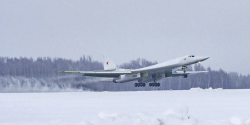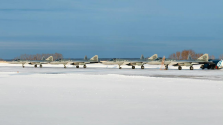You are using an out of date browser. It may not display this or other websites correctly.
You should upgrade or use an alternative browser.
You should upgrade or use an alternative browser.
Russian Military News, Reports, Data, etc.
- Thread starter tphuang
- Start date
Lethe
Captain
Russia has a "vanity" carrier because it has no strategic need for carriers and the problems which can be optionally solved by a carrier, can be solved by other means more efficiently. It maintains a carrier because it is an industrial special interest, much more than a political status symbol. If Russia loses its only carrier then an entire area of military production becomes theoretical, and in this market it means nonexistent. Without Kuznetsov there is no MiG-29K and without it there's no entry into Indian naval aviation and additional funding for Mikoyan etc.
The influence of Russian defense industry on procurement choices is greatly overlooked. Russian MIC is second only to American MIC in terms of its economic and political influence. The entire modernization of aviation in recent decade has been driven by special interest and economic policy and not by rational choices.
Nobody wants to see industrial contracts awarded for inferior or ill-suited equipment owing to corruption or as a form of make work, but we should acknowledge that industrial considerations have a legitimate role to play in questions of national security. Maintaining design and engineering expertise, facilities, a skilled and experienced workforce, these are all important things.
The question for me is: to what end? Industrial policy needs to be linked to a broader vision for the nation, and to the long-term realities of costs, budgets, and requirements/priorities. This is where I see the problem, in that Russia has not sufficiently adjusted to the reality of its diminished power in the world and scaled its ambitions accordingly. Hence, instead of fielding very credible and modern armed forces still considerably exceeding those of any other nation in Europe, we instead bear witness to the undignified end of Moskva (indeed, the entire Ukraine conflict), the unedifying saga of Admiral Kuznetsov, and any other number of less dramatic examples of a national ego writing cheques that it can't cash.
It seems to me that Russia's rapid economic growth throughout the 2000s bears much of the responsibility for this state of affairs, in that this period of economic growth allowed planners at all levels to dream of a return to a glorious pseudo-Soviet future. It follows from this vision that all manufacturing facilities, specialist capabilities and expertise should be maintained in anticipation of this glorious future, and that large numbers of older ships, aircraft, vehicles, etc. should be maintained because they would ultimately be replaced in equal or greater numbers. This was the era in which the Leader destroyers and PAK DA were first conceived. In the real world, Russia's economic performance has never returned to pre-GFC levels, and there is little reason to think the next decade will be any better than the last. Indeed, it stands a good chance of being worse. At a certain point, Russia's visions need to align with reality.
An important but forgotten factor is the political climate of the 1990s and the peace dividend that majority of political establishment in America supported. That was the context of that decision. Washington's reaction to 9/11 should have changed Russia's entire strategy but that would require pragmatic thinking, and that would require recognizing a permanent loss of status - something Moscow was (and is still) unwilling to accept with tragic consequences. Psychologically it's always easier to grow than to shrink.
Can you expand on this? Why should Washington's reaction to 9/11 (by which I assume you mean the GWOT and the invasions of Afghanistan and Iraq) have changed Russia's strategy?
A new way to protect Russian aircraft from homing missiles was proposed by scientists from the All-Russian Research Institute of Experimental Physics. There is no video of this, so we just explain. Scientists propose to tow decoys from metallized balls connected by cable segments behind aircraft. Balls and their diameter are selected in such a way that the decoy could imitate another aircraft, more visible to radars and missile homing systems.
Moskov and Kuzentov are left over from Soviet times. It has nothing to do with Russian engineering.we instead bear witness to the undignified end of Moskva (indeed, the entire Ukraine conflict), the unedifying saga of Admiral Kuznetsov, and any other number of less dramatic examples of a national ego writing cheques that it can't cash.
Russian engineering are those thousands of cruise missiles , air defense systems that had turn effectively Ukraine into a Cage . and those still not top of the line system like S350 widely deployed.
Russia put a Borei-A class strategic nuclear submarine into service and launched another to the water. This means they have 6 latest generation SSBNs in service. Plus several older generation Delta IV (5) and III (1) from 1980s. For comparison the UK uses 4 submarines from the early 1990s, France uses 4 submarines from the late 1990s, and US has 18 submarine designs from early 1980s.
MOSCOW, December 29. /TASS/. The nuclear-powered submarine Imperator Alexander III was set afloat on Thursday, with President Vladimir Putin partaking in the ceremony.
It is a seventh missile-carrying strategic nuclear-powered submarine of the Borei-A class. Such submarines are capable of carrying 16 inter-continental ballistic missiles Bulava. The sea trials of The Imperator Alexander III are due to begin in June 2023. The previous, sixth submarine of the family (The Generalissimus Suvorov) joined the Russian Navy in a special ceremony on Thursday.
MOSCOW, December 29. /TASS/. The nuclear-powered submarine Imperator Alexander III was set afloat on Thursday, with President Vladimir Putin partaking in the ceremony.
It is a seventh missile-carrying strategic nuclear-powered submarine of the Borei-A class. Such submarines are capable of carrying 16 inter-continental ballistic missiles Bulava. The sea trials of The Imperator Alexander III are due to begin in June 2023. The previous, sixth submarine of the family (The Generalissimus Suvorov) joined the Russian Navy in a special ceremony on Thursday.
Last edited:
This settle debate about performance. also the tail is visibly changed for this model.
Two Tu-160Ms transferred to the flight test station
“The Tu-160 is the most important part of the Russian nuclear triad, so the modernization of combat vehicles and the resumption of production of these strategic bombers is our priority task. The upgraded missile carriers are superior in performance to their predecessors; they have received new avionics, NK-32-02 engines and other systems. In the coming years, the production of these machines will increase,” said Sergey Chemezov, General Director of Rostec State Corporation
[IL-76MD-90A] At the end of December, PJSC IL-Aviastar manufactured and handed over to the Russian Aerospace Forces a new IL-76MD-90A which completes the delivery of BTA aircraft this year. The company increased production volume, reaching the production rate of five aircraft per year..
Two Tu-160M strategic missile carriers transferred to the flight test station
30.12.2022Two regular Tu-160M strategic missile carriers have been handed over for flight tests. The first aircraft is mass-produced under the Tu-160M reproduction program and the second is a combat aircraft that has undergone a deep modernization, the press service of the United Aircraft Corporation reported.
At the flight test station, the necessary checks of aircraft systems and engines, as well as on-board radio-electronic equipment, will be carried out. After that, the aircraft will be transferred to the operating organization.
In December, the next flight of the first newly manufactured prototype of the Tu-160M strategic missile carrier also took place. The aircraft has completed the factory test program. As part of the flight, maneuvers were performed to check the stability and controllability of the aircraft in the air, the performance of aircraft systems and engines, as well as on-board electronic equipment.

The first flight of this aircraft took place in January 2022 at the airfield of the Kazan Aviation Plant. In the new aircraft, 80 percent of the systems and equipment have been updated and modernized. The missile carrier is equipped with NK-32 engines of the second series.
As part of the implementation of the program under the state contract between the Ministry of Industry and Trade of Russia and Tupolev PJSC, the design documentation for the Tu-160M aircraft was completely digitized in a short time, the technology for vacuum welding of titanium products was restored, the production of aircraft airframe units was resumed, and new cooperation was formed from industrial enterprises in the field of metallurgy, aircraft industry, mechanical engineering and instrument making.


